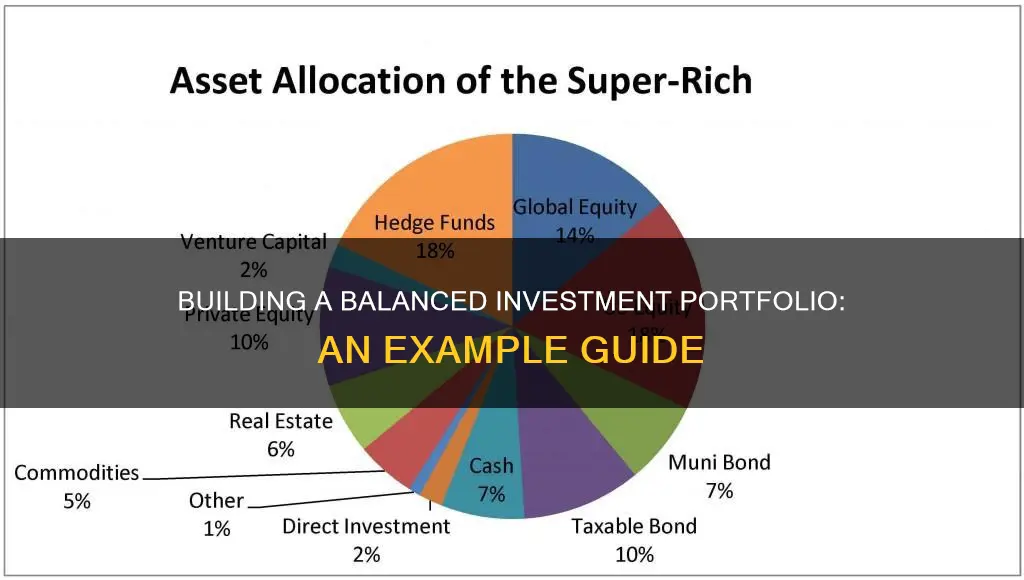
An investment portfolio is a collection of financial investments or assets owned by an individual or institution. The term portfolio comes from the Latin folium, meaning to carry leaves, as in papers. The core of a portfolio is usually made up of stocks, bonds, and cash, but it can also include real estate, gold, paintings, and other art collectibles.
A well-diversified portfolio is important to reduce risk and increase returns. Different types of assets in a portfolio can provide diversification, which helps to spread out the risk so that an investor is not too reliant on any one company or sector.
- 40% US large-cap stocks
- 10% US small-cap stocks
- 10% international stocks
- 25% US investment-grade bonds
- 10% US high-yield bonds
- 5% REITs
What You'll Learn

Stocks
There are two main types of stocks: common stock and preferred stock. Common stock is the most common type, offering ownership and voting rights. Preferred stock is a hybrid security with characteristics of both debt and equity, usually paying fixed dividends and having priority over common stockholders in the event of liquidation.
When building an investment portfolio, it is important to consider your risk tolerance and investment goals. Stocks are generally considered riskier than other asset classes, such as bonds, but they can deliver higher returns over the long term. If you are comfortable with taking on more risk, you may allocate a larger portion of your portfolio to stocks. On the other hand, if you have a low-risk tolerance, you may want to allocate a smaller portion of your portfolio to stocks and focus more on less risky assets such as bonds.
It is also important to diversify your stock holdings by investing in a variety of companies across different sectors, industries, and geographic regions. This helps to reduce the impact of any single stock's performance on your portfolio and can lead to more stable returns.
Additionally, when investing in stocks, it is wise to consider the time horizon of your investment goals. If you are investing for the long term, such as for retirement, you may be able to take on more risk and invest a larger portion of your portfolio in stocks. On the other hand, if you are investing for shorter-term goals, you may want to allocate a smaller portion of your portfolio to stocks and focus more on less risky, more liquid assets.
Finally, when choosing individual stocks to invest in, it is important to research and select companies that fit within your investment parameters. This may include companies with strong growth potential, companies that pay dividends, or companies that are undervalued by the market.
Understanding Portfolio Investment: Strategies for Success
You may want to see also

Bonds
There are several types of bonds, including:
- Corporate bonds: These are issued by companies to raise capital for initiatives like expansion and research and development. The interest earned is usually taxable, and corporate bonds tend to offer higher yields than government or municipal bonds.
- Municipal bonds: These are issued by cities, towns, or states for public projects such as schools, roads, and hospitals. Municipal bonds often have two types: general obligation and revenue. The former is backed by the full faith and credit of the issuing municipality, while the latter is paid back with the income generated by the project.
- Treasury bonds: Issued by governments and considered risk-free, these bonds are backed by the full faith and credit of the issuing government. While they are subject to federal tax, they are usually exempt from state and local taxes.
- Income generation: Bonds provide a fixed amount of income at regular intervals through coupon payments.
- Diversification: Bonds can help diversify a portfolio that includes stocks and other asset classes. They typically have an inverse relationship with stocks, so when the stock market is down, bonds become more appealing.
- Risk management: Bonds are generally considered less risky than stocks because they are less sensitive to macroeconomic risks, such as economic downturns and geopolitical events.
- Capital preservation: Bonds typically carry less risk than stocks, making them a good choice for investors who want to protect their investment and have less time to recoup losses.
However, it is important to note that bonds also come with certain risks:
- Interest rate risk: When interest rates rise, bond prices fall, and bonds you hold can lose value.
- Inflation risk: If the rate of inflation is higher than the fixed income provided by the bond, the investor loses purchasing power.
- Credit risk: There is a possibility that the issuer could default on their debt obligation.
- Liquidity risk: This refers to the possibility that an investor wants to sell a bond but cannot find a buyer.
Overall, bonds play a crucial role in investment portfolios by providing income, diversification, and risk management. They are a stable investment option that can help balance out riskier assets.
Savings vs Investments: Macroeconomics' Distinct Financial Strategies
You may want to see also

Real estate
A real estate investment portfolio is a collection of real estate investment assets. It is part of a person's overall collection of assets and investments, which may also include stocks, bonds, mutual funds, exchange-traded funds (ETFs), precious metals, and cryptocurrencies.
- Single-family rental homes
- Small multifamily buildings
- Commercial properties
- Rental properties
- Flipped homes
- Real estate investment trusts (REITs)
The primary goal of building a real estate portfolio is to help an investor achieve their financial objectives. This could mean building a collection of cash-flowing rental properties, hedging against inflation and stock market volatility, or building generational wealth.
- Learn about real estate investing: Understand the business and different investment strategies, such as fixing-and-flipping homes, wholesaling property, or buying-and-holding for long-term appreciation.
- Write a real estate business plan: Define your investing strategy, investment goals, and a plan for financing property purchases.
- Know what makes a good rental property: Look for features that make a city and home suitable for rental property, such as renter-occupied households, available homes for rent, and neighborhood ranking.
- Find a rental property: Get detailed information about rental property investments in different markets. Consider factors such as property description, due diligence documents, tenant information, and financial metrics.
- Purchase an investment property: Put together the down payment, check your credit score, get pre-approved for a mortgage, negotiate with the seller, and order a home inspection and appraisal.
- Gradually scale up the real estate portfolio: Use strategies like the snowball method to acquire more rental properties over time. For example, use the cash flow from one rental property to save for the down payment on another.
Remember, it's important to do careful planning and research when building a real estate investment portfolio.
Crafting a Compelling Investment Narrative: Guide to Portfolio Storytelling
You may want to see also

Commodities
There are several ways to invest in commodities. One way is to invest directly in the commodity itself, although this can be challenging as it requires finding a buyer and handling delivery logistics. Another way is to use commodity futures contracts, which offer direct exposure to changes in commodity prices. Buying shares of exchange-traded funds (ETFs) that specialise in commodities is also an option. ETFs offer investors a convenient and accessible way to invest in commodities without owning the physical commodity. Additionally, investors can buy shares of stock in companies that produce commodities.
Experts recommend allocating around 5-10% of a portfolio to a mix of commodities. However, those with a lower risk tolerance may consider a smaller allocation.
Building a Diverse Investment Portfolio: Strategies for Success
You may want to see also

Mutual funds and ETFs
Mutual funds and exchange-traded funds (ETFs) are two popular ways of investing in a diversified portfolio. Both types of funds allow investors to gain exposure to a wide range of securities and assets, including stocks, bonds, commodities, cash, and cash equivalents. However, there are some key differences between the two.
Mutual funds have been a popular investment choice for many years, with the first mutual fund launched in 1924. They tend to be actively managed, meaning a fund manager picks and chooses the securities to buy and sell within the fund to try and beat the market. As a result, mutual funds often have higher fees and expense ratios than ETFs. Mutual funds also typically have minimum initial purchase requirements and can only be bought and sold at the end of each trading day, when the net asset value (NAV) is calculated.
ETFs, on the other hand, are a newer type of investment fund that first appeared in 1993. They are usually passively managed, meaning they track a preset market index or sector sub-index rather than being actively managed by a fund manager. ETFs are traded on exchanges like stocks, and can be bought and sold throughout the trading day. They generally have lower fees and expense ratios than mutual funds, and often have no minimum initial purchase requirement.
When deciding between mutual funds and ETFs, investors should consider their investment goals, risk tolerance, and time horizon. Mutual funds may be a good choice for those who want a more actively managed fund and are willing to pay higher fees. ETFs, on the other hand, offer low-cost, passive investment options that can be traded more flexibly throughout the day.
Investment Opportunities in Pakistan: Where to Invest Your Savings
You may want to see also
Frequently asked questions
An investment portfolio is a collection of financial investments or assets owned by an individual or institution. These assets can include stocks, bonds, commodities, cash, real estate, and more.
Investment portfolios allow individuals to diversify their investments, reducing risk and potentially increasing returns. Portfolios can also provide a source of income through dividend payments or interest and help individuals work towards their financial goals.
Building an investment portfolio involves determining your financial goals, risk tolerance, and time horizon. You can then choose specific investments that align with these factors and regularly monitor and adjust your portfolio as needed.
A diversified portfolio contains a wide range of investments across different asset classes, sectors, and geographic regions. Diversification helps to reduce the overall risk of the portfolio by ensuring that all investments are not dependent on the same market factors.
An aggressive portfolio takes on more risk by investing in high-growth industries and younger companies, while a conservative portfolio focuses on preserving capital and generating stable returns through lower-risk investments such as bonds and dividend-paying stocks.







